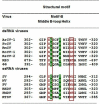Molecular characterization of a novel cryptic virus infecting pigeonpea plants
- PMID: 28771507
- PMCID: PMC5542627
- DOI: 10.1371/journal.pone.0181829
Molecular characterization of a novel cryptic virus infecting pigeonpea plants
Abstract
A new member of the genus Deltapartitivirus was identified containing three dsRNAs with an estimated size of 1.71, 1.49 and 1.43 kb. The dsRNAs were extracted from symptomless pigeonpea [Cajanus cajan (L.) Millspaugh] plants cv. Erra Kandulu. This new virus with 4.64 kb genome was tentatively named Arhar cryptic virus-1 (ArCV-1). The genomic RNAs were amplified and characterized by sequence independent single primer amplification. The dsRNAs shared a highly conserved 16 nt 5' non-coding region (5'-GATAATGATCCAAGGA-3'). The largest dsRNA (dsRNA-1) was identified as the viral RNA dependent RNA polymerase (replicase), predicted to encode a putative 55.34 kDa protein (P1). The two other smaller dsRNAs (dsRNA-2 and dsRNA-3) predicted to encode for putative capsid proteins of 38.50kDa (P2) and 38.51kDa (P3), respectively. Phylogenetic analysis indicated that ArCV-1 formed a clade together with Fragaria chiloensis cryptic virus, Rosa multiflora cryptic virus and Rose cryptic virus-1, indicating that ArCV-1 could be a new member of the genus Deltapartitivirus. ArCV-1 3Dpol structure revealed several interesting features. The 3Dpol in its full-length shares structural similarities with members of the family Caliciviridaeand family Picornaviridae. In addition, fourth dsRNA molecule (dsRNA-2A), not related to ArCV-1 genome, was found in the same plant tissue. The dsRNA-2A (1.6 kb) encodes a protein (P4), with a predicted size of 44.5 kDa. P4 shares similarity with coat protein genes of several cryptic viruses, in particular the bipartite cryptic viruses including Raphanus sativus cryptic virus-3. This is the first report of occurrence of a cryptic virus in pigeonpea plants.
Conflict of interest statement
Figures







Similar articles
-
Complete nucleotide sequences and genome characterization of a novel double-stranded RNA virus infecting Rosa multiflora.Arch Virol. 2008;153(3):455-62. doi: 10.1007/s00705-007-0008-3. Epub 2008 Jan 3. Arch Virol. 2008. PMID: 18172568
-
Deep sequencing of dsRNAs recovered from mosaic-diseased pigeonpea reveals the presence of a novel emaravirus: pigeonpea sterility mosaic virus 2.Arch Virol. 2015 Aug;160(8):2019-29. doi: 10.1007/s00705-015-2479-y. Epub 2015 Jun 10. Arch Virol. 2015. PMID: 26060057
-
Nucleotide sequence of the tripartite Fragaria chiloensis cryptic virus and presence of the virus in the Americas.Virus Genes. 2008 Feb;36(1):267-72. doi: 10.1007/s11262-007-0186-9. Epub 2007 Dec 22. Virus Genes. 2008. PMID: 18157739
-
The complete nucleotide sequence and genome organization of Fig cryptic virus, a novel bipartite dsRNA virus infecting fig, widely distributed in the Mediterranean basin.Virus Genes. 2011 Jun;42(3):415-21. doi: 10.1007/s11262-011-0581-0. Epub 2011 Feb 12. Virus Genes. 2011. PMID: 21318240
-
Deep sequencing of pigeonpea sterility mosaic virus discloses five RNA segments related to emaraviruses.Virus Res. 2014 Aug 8;188:27-31. doi: 10.1016/j.virusres.2014.03.022. Epub 2014 Mar 28. Virus Res. 2014. PMID: 24685674
Cited by
-
Transcriptome Mining Expands Knowledge of RNA Viruses across the Plant Kingdom.J Virol. 2022 Dec 21;96(24):e0026022. doi: 10.1128/jvi.00260-22. Epub 2022 May 31. J Virol. 2022. PMID: 35638822 Free PMC article.
-
High-Throughput Sequencing Application in the Diagnosis and Discovery of Plant-Infecting Viruses in Africa, A Decade Later.Plants (Basel). 2020 Oct 16;9(10):1376. doi: 10.3390/plants9101376. Plants (Basel). 2020. PMID: 33081084 Free PMC article. Review.
-
The Endosphere Microbiome of Ginseng.Plants (Basel). 2022 Feb 2;11(3):415. doi: 10.3390/plants11030415. Plants (Basel). 2022. PMID: 35161395 Free PMC article. Review.
-
Identification and Characterization of a Novel Quanzhou Mulberry Virus from Mulberry (Morus alba).Viruses. 2023 May 9;15(5):1131. doi: 10.3390/v15051131. Viruses. 2023. PMID: 37243217 Free PMC article.
References
-
- Nene YL, Kaiser WJ, Grewat JS, Kannaiyan J, Beniwal SPS. An annotated bibliography of pigeonpea diseases, 1906–81. Patancheru, A.P. 502 324, India: international Crops Research Institute for the Semi-Arid Tropics; 111pp, 1985.
-
- Bhattiprolu SL. The occurrence of mosaic mottle, a viroid disease of pigeonpea (Cajanus cajan) in India. J Phytopathol. 1993; 137: 55–60.
-
- Elbeaino T, Digiaro M, Uppala M, Sudini H. Deep sequencing of dsRNAs recovered from mosaic-diseased pigeonpea reveals the presence of a novel emaravirus, pigeonpea sterility mosaic virus 2. Arch. Virol. 2015; 160: 2019–2029. doi: 10.1007/s00705-015-2479-y - DOI - PubMed
-
- Vemana K, Goud TES, Reddy DL, Venkateswarlu NC, Naik KSS, Kumar DS, et al. First Report of tobacco streak virus infecting pigeonpea (Cajanus cajan) in India. PlantDis.2014; 98: 287 doi: 10.1094/PDIS-07-13-0731-PDN - DOI - PubMed
-
- Boccardo G, Lisa V, Luisoni E, Milne GR. Cryptic plant viruses. Adv Virus Res. 1987; 32: 171–214. - PubMed
MeSH terms
Substances
LinkOut - more resources
Full Text Sources
Other Literature Sources
Research Materials

